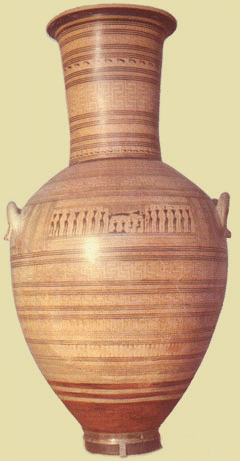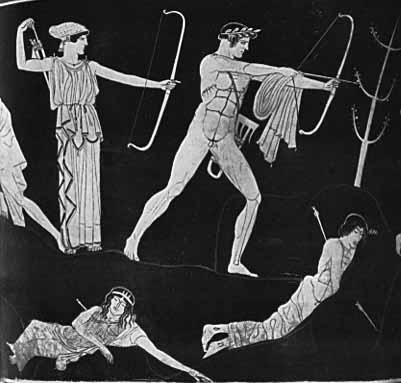GREEK VASE PAINTING
Slide 1: Geometric funerary amphora c.800
Funerary amphora in geometric style, depicting (laying – out) and lamentation over the dead. Found in Dipylum. 800 B.C. National Museum Athens
Slide 2: Geometric krater c.750
The krater was a common type of vessel in early Greek pottery. This 8 th- century example from the Dipylon cemetery, about 101. 25 cm (40 — in) high, is decorated with a funeral procession in which the figures are highly stylized. The band around the top features the meander design associated with early Greek art.
Black figure
Slide 3: Nessos painter ‘Herakles and Nessos’ (Athens) c.620
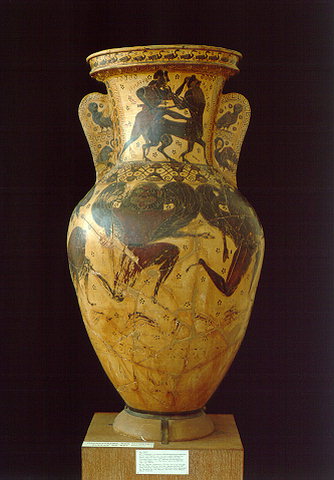
Once, when Herakles was traveling with his wife, Deianeira, they came to and had to cross the river Euenos. The river was swollen by rain, but the Centaur Nessos was ferrying people across, for a price. Herakles could ford the river with little trouble, but he agreed to let the Centaur carry Deianeira across. In the middle of the river, though, Nessos attempted to accost, or make off, with his passenger. Herakles, responding to his wife ‘s screams, shot the Centaur with an arrow. However, as he was dying, Nessos told Deianeira that, if she ever suspected her husband of infidelity, a shirt soaked in his (Nessos ‘s) blood would be a love charm, and bring him back to her. She had reason to be suspicious, and soaked a shirt in the centaur ‘s blood. When her suspicions came to pass, she sent Herakles the blood – soaked shirt. When he put it on, the poison, from the Hydra, that he had dipped his arrows in, burned him so that the only cure was his apotheosis.
This is the story as it has come down to us, but many depictions in Greek art do not agree with this
version in all details. For example, the Nessos Amphora (left) shows Herakles and Nessos, both identified by inscriptions, in close combat, with the hero dispatching the centaur with his sword. Deianeira is not present in this portrayal. It is supposed there were a number of versions of the story current at one time or another, and the differing portrayals reflect this. There are also depictions with only Nessos and Deianeira, at various stages of the assault. In some, she ‘s contentedly riding, in others, he’s making his move. Besides Nessos, a centaur identified as Eurytion is also frequently shown as being chastised for an assault on Herakles ‘s wife (e.g., London 96.7 – 16.5), and, on a stamnos from Polygnotos ‘s workshop, Naples 3089, a centaur inscribed Dexamenos, perhaps in error for Eurytion, is in similar straits.
Slide 4: Kleitas & Ergotimos Francois vase (Florence) c.560?

Slide 5: Amasis painter ‘Dionysos and two Maenads’ (Paris) c.540-530

artist Amasis Painter, period Archaic (Ancient Greek Art), date 540 BC
This beautiful black figure vase painting by the Amasis Painter depicts Dionysos with a pair of attendant maenads. The image appears on a type of vessel that the ancient Greeks called an amphora. Amphorae (the plural form of the word amphora) were used to store such treasures as wine and oil.
The body of the vase is adorned with a gorgeous group of figures. Dionysos, the Greek god of wine and the theatre, stands on the left. The god is bearded and holds a kantharos (this kind of wine cup is often used as a symbol of Dionysos) in one of his hands. The right side of the vase features two women, who are often identified as maenads (female followers of Dionysos). These women are intertwined and clad in dark, intricately detailed garments. One of the maenads is holding a hare, while the other is carrying a deer. Each of the female figures is also grasping a sprig of stylized ivy. Notice how the skin of the male figure – Dionysos – is dark, while the female figures – the maenads – both have pale, buff colored skin.
The decorative details on the vase are bold and beautifully rendered. Large spirals serve to frame the composition in the center, and the figures also stand on a band of stylized grape leaves. This enchanting work is a masterpiece of the black figure style of vase painting.
Slide 6: Exekias ‘Achilles slaying Penthisilea’ (B.M) c.530-525

Black figure amphora, Achilles slaying the Amazon queen Penthesilea, by Exekias 540 BC
Slide 7: Exekias ‘Achilles and Ajax playing draughts’ (Vatican) c.540

This amphora shows the increasing skill of the Athenian vase painter in depicting the human form and in telling the human story. It was common for the vessel to be thrown and assembled by one person, while the painting was accomplished by another. This amphora is particularly well proportioned, with its volume swelling from the foot to its shoulder, from which elegant handles spring to the neck. The painter of this amphora, Exekias, was a painter who excelled in composition and that is evident here, where light and dark areas are skillfully balanced. The scene is from the Trojan Ware, and we see two of the most famous figures from this story, Achilles and Ajax. Achilles is at left, and Ajax is on the right. Both have rested their shields and spears, and Ajax has removed his helmet. Note the skillful way in which Exekias has drawn the spears to create a triangular line which leads the eye to the handles. Also see how this line is completed by the shapes of the shields, bringing our eyes back into the composition.
These two warriors are shown taking a respite from their battles, and playing a game of checkers (draughts) on a board. They intently focus on the game, moving their pieces around the board. Note the frontal eye, which seems to stare at the viewer, even though they are looking at the game board. While body proportions are still not anatomically correct, Exekias indicates volume and shape by using sgraffito, carving linear detail into the black shapes of the figures. Rather than focusing on the battles to come, Exekias here captures the more human moment of two warriors at rest, trying to take their minds off their worries of what is soon to come. A double honeysuckle frieze surrounds the vessel above the action. The population at this time was mostly illiterate, but the action depicted here would have been recognized by most people. The story illustrated here is of a war that took place over 600 years before this vase was painted, and together with the writings of Homer, these vases vividly illustrate the history of this time.
Achilles is best known from the phrase ‘Achilles Heel.’ He was the commander of the Trojan army and thought to be invincible….
Red figure
Slide 8: Euphronios ‘Youths oiling themselves’ (Berlin) c.510

Could not find Youths oiling themselves, Euphronios 520 BC – 470 BC, potter, Vase-painter, Greek
Euphronios was a vase – painter and potter working in the red – figure technique in Athens from about 520 to 470 B.C. He signed his name on eighteen vases, six times as painter and twelve times as potter. To judge by their drawing style, the vases that he signed as potter seem to be later than those he signed as painter.
In his early career Euphronios was one of a group of Athenian vase – painters who have been named the Pioneers by scholars today. Working about 520 to 500 B.C., they were the first to exploit the possibilities of drawing in the new red – figure technique. Like his colleagues, Euphronios was interested in showing the human body in a variety of poses, and he used overlapping and foreshortening to give his scenes a sense of depth. On their vases, the Pioneers often depicted one another and even exchanged playful insults about each other.
Later in his career, Euphronios ‘s signature as potter appeared alongside the names of several of the finest vase – painters of this period, including Douris, Makron, and Onesimos. The precise details surrounding Euphronios ‘s later role as potter are unclear. Perhaps as he got older and his eyesight failed, he switched to the more tactile, less visual craft of potting a vase. Or the potter signature may mean that Euphronios actually owned the workshop, a sign of his prosperity and success in the industry.
Slide 9: Euphronios ‘Heracles and Antaeus’ c.515

Slide 10: Berlin painter ‘Athena’ (Basel) c.500-480
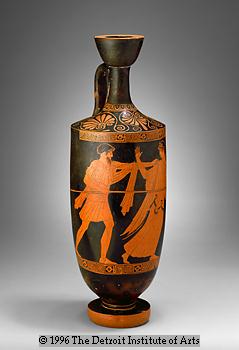
Attic Lekythos with Scene of a Man Pursuing a Woman, 470 BC, red-figure ware, Berlin Painter
Greek
Slide 11: Foundry painter lovemaking (Getty) c.480

Tondo: lovemaking, Collection of the J. Paul Getty Museum, Malibu, California
Slide 12: Niobid painter ‘Apollo & Artemis slaying Niobids’ (Paris) c.460
Slide 13: Niobid painter ‘Ceriauromachy & Amazonomachy’ (Agrigento) c.460
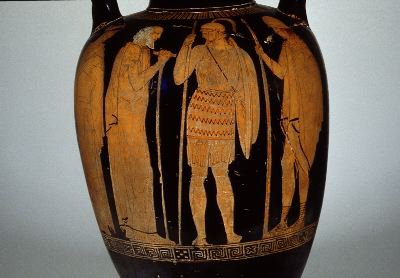
Slide 14: Pronomos painter ‘Satyr play’ (Naples) c.410

An Athenian red figure volute krater (signed by the painter, Pronomos), from the end of the fifth century, showing the cast of a satyr play. Note the flute player (also lyre players), phallos, masks, Dionysos (center), and actor dressed as Herakles (all of which could appear in Old Comedy).
ROMAN PAINTING
Introduction to the four styles
First style
Slide 15: House of Sallust, Pompeii
Slide 16: House of the Griffins, Palatine (2)(image not found)
Second style
Slide 17: Villa of Mysteries, Pompeii, Cubiculum 16 (50-40BC)(image not found)
Slide 18: Boscoreale, Villa of P.Fannius Sinistor (50-40BC)(image not found)
Slide 19: House of the Labyrinth, Pompeii

Slide 20: House of the Labyrinth floor plan, Pompeii

Slide 21: House of Augustus, Palatine c.30BC
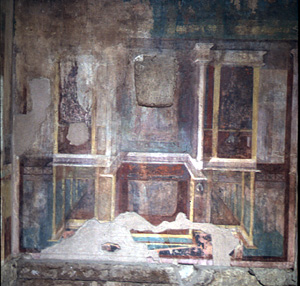
Slide 22: Casa di Livia, Palatine c.30BC
Phase IIb: about 25-15 B.C.-> the return to the so called flat wall painting has been completed now; in the center of a wall painting, there is a big painted scene and the rest of the decoration is a slight reminiscence to architecture. There is no perspective (cf. Casa di Livia, Palatine, Rome; Aula Isiaca, Palatine, Rome; Villa della Farnesina, Rome (Tiber); Casa di Obellio Firmo, Pompeii).
Slide 23: Farnesina villa, Terme Museum c.20BC
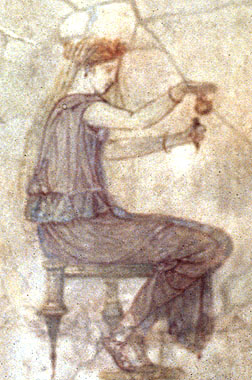
Slide 24: Painted vault of Aula Isaica, Rome c.30BC(image not found)
Third style
Slide 25: House of M.Cornelius Fronto, Pompeii AD40-50

Fourth style
Slide 26: Domus Aurea (oriental style decoration)
The Domus Aurea or golden house is one of Nero ‘s most extravagant projects.After two – thirds of Rome were decimated by the great fire in 64, Nero used this land as a site for his new palace.It was not so much a palace as a series of buildings scattered over a landscaped countryside including an artificial lake.It was extravagantly crafted, boasting rooms and hallways decorated almost entirely in gold.Severus and Celer, the architects in charge of the project, utilized a revolutionary movement in architecture that emphasized arches and interior spaces.
Slide 27: House of the Vetii, Pompeii

Slide 28: House of the Vetii small & large oecus(image not found)
Slide 29: House of the Vetii small & large triclinium (62)(image not found)
Slide 30: Coloured stucco, Naples museum (70-79AD)(image not found)
Slide 31: ‘Baroque’ theatrical architecture (70-79AD) Later Roman wall decoration(image not found)
Slide 32: Tomb of the Pancratii, Rome (c. 150AD)

Slide 33: Ceiling decoration, Ostia (c. 160AD)(image not found)
Slide 34: Diana of the Spring, Rome (c.330-350AD)(image not found)
Narrative / History painting
Slide 35: Alexander mosaic (House of the Faun, Pompeii, late 2nd / early 1st BC)
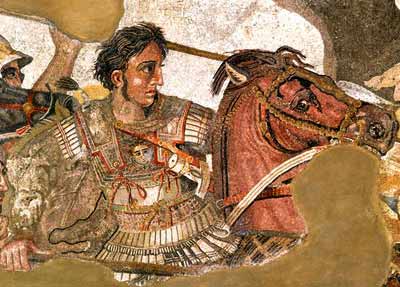
Slide 36: Achilles on Scyros, Pompeii (3rd qtr 1st AD) 1m high(image not found)
Slide 37: Polyphemus & Galatea, Boscotrecase (10BC-7AD)(image not found)
Slide 38: Odyssey landscape (Vatican from Esquiline c.40BC)

Slide 39: The Trojan Horse, Naples (70-79AD)(image not found)
Slide 40: Naval Battle, House of Vetii, Pompeii

Slide 41: Surrender of Briseis by Achilles, Pompeii (c.70AD)

Slide 42: Hercules & Telephus, Naples

Hercules And Telephus, IV Style, Basilica, Herculaneum
This painting is thought to reproduce a Hellenistic original. The scene represents the founding myth of the Attalid rulers of Pergamum. Hercules recognizes his natural son Telephus (suckled by a doe in lower left), in the presence of Arcadia (seated.)
The painting has been criticized by art historians because of a perceived lack of unity in technique and composition. The figures look, to some critics, as if they had been copied from several different originals.
Slide 43: Theseus Triumphant, Naples(image not found)
Slide 44: Perseus frees Andromeda, Naples

Perseus frees Andromeda, Naples 8998 and unknown number, wall paintings, height 1.25 m, ~ 70 (model – 200 B.C.), prov. Pompeii
Slide 45: Sacrifice of Iphigenia, Naples
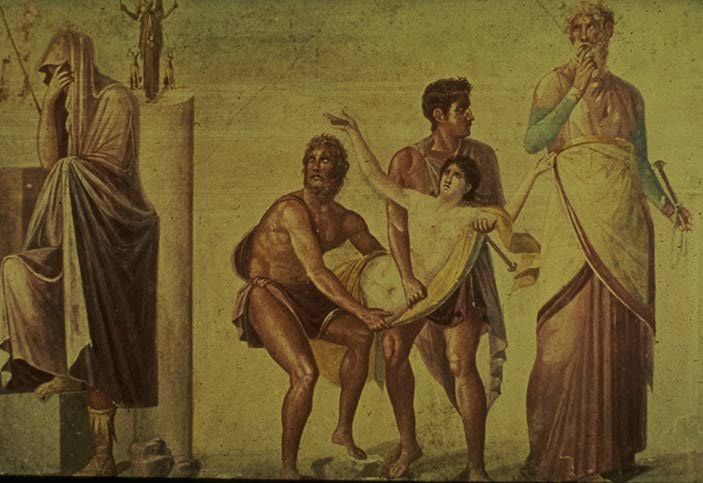
Note the representation of extreme grief by covering the face as it is so difficult to show grief from laughing
Slide 46: Three Graces, from Pompeii

Frieze
Slide 47: Villa of the Mysteries, Pompeii (60-50BC)(image not found)
Genre
Slide 48: Victory of a tragic actor, Herculaneum(image not found)
Slide 49: Scene from a comedy, Naples(image not found)
Landscape
Slide 50: Farnesina Villa, Terme museum (c.30BC)(image not found)
Slide 51: Pastoral scene, Pompeii & Paris on Mount Ida (60-70AD)(image not found)
Architectural scenes
Slide 52: Stabia, Campanian harbour (70-79AD)(image not found)
Slide 53: House of M.Lucretius Fronto, Pompeii 3 scenes

Portraits
Slide 54: Portrait of a girl with stylus (Naples Museum, 3rd qtr lst Century AD)

Slide 55: Portrait of law student and his wife (Naples, c.60-70AD)

Could not find law student and wife, this is a late mummy mask although not of the same quality
Still Life
Slide 56: Peaches & Glass jar (Herculaneum, c.56AD)
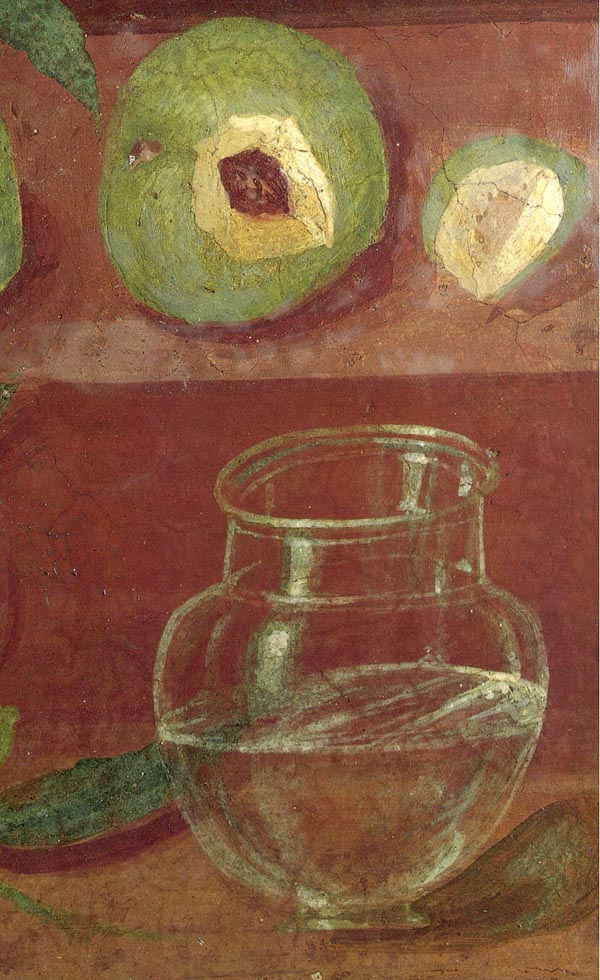
Slide 57: Detail from wall painting, Pompeii(image not found)

